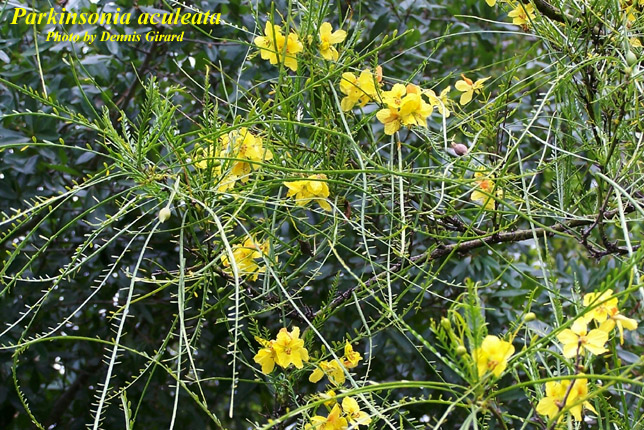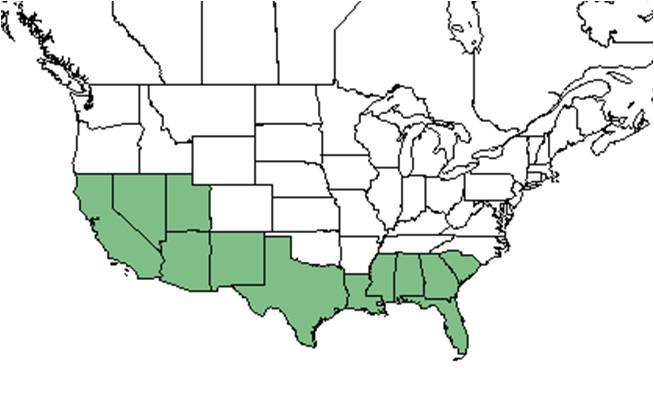Difference between revisions of "Parkinsonia aculeata"
KatieMccoy (talk | contribs) |
HaleighJoM (talk | contribs) (→Ecology) |
||
| (29 intermediate revisions by 7 users not shown) | |||
| Line 3: | Line 3: | ||
{{taxobox | {{taxobox | ||
| name = Parkinsonia aculeata | | name = Parkinsonia aculeata | ||
| − | | image = | + | | image = Park_acul.jpg |
| − | | image_caption = | + | | image_caption = Photo by Dennis Girard, [http://www.florida.plantatlas.usf.edu/Default.aspx Atlas of Florida Vascular Plants] |
| regnum = Plantae | | regnum = Plantae | ||
| divisio = Magnoliophyta - Flowering plants | | divisio = Magnoliophyta - Flowering plants | ||
| Line 18: | Line 18: | ||
}} | }} | ||
| − | Common | + | Common names: Jerusalem thorn; Mexican Palo Verde |
==Taxonomic notes== | ==Taxonomic notes== | ||
| + | Synonyms: none.<ref name="weakley">Weakley, A.S. 2015. Flora of the southern and mid-atlantic states. Working Draft of 21 May 2015. University of North Carolina at Chapel Hill, Chapel Hill, North Carolina.</ref> | ||
| + | |||
| + | Varieties: none.<ref name="weakley">Weakley, A.S. 2015. Flora of the southern and mid-atlantic states. Working Draft of 21 May 2015. University of North Carolina at Chapel Hill, Chapel Hill, North Carolina.</ref> | ||
==Description== | ==Description== | ||
<!-- Basic life history facts such as annual/perrenial, monoecious/dioecious, root morphology, seed type, etc. --> | <!-- Basic life history facts such as annual/perrenial, monoecious/dioecious, root morphology, seed type, etc. --> | ||
| + | ''P. aculeata'' is a thorny shrub with weakly papilionaceous flowers.<ref name="radford">Radford, A. E., Ahles, H. E., & Bell, C. R. (1968). Manual of the vascular flora of the Carolinas. Chapel Hill: University of North Carolina Press.</ref> The leaflets are 1-5 mm long while the leaves are 2-pinnate and subsessile.<ref name="weakley">Weakley, A.S. 2015. Flora of the southern and mid-atlantic states. Working Draft of 21 May 2015. University of North Carolina at Chapel Hill, Chapel Hill, North Carolina.</ref> | ||
==Distribution== | ==Distribution== | ||
| + | It is a native to Mexico but has spread and become naturalized in Florida.<ref name="pacific">[[http://www.pacifichorticulture.org/articles/mexican-palo-verde/]] Pacific Horticulture. Accessed: February 17, 2016</ref> | ||
| + | |||
==Ecology== | ==Ecology== | ||
===Habitat=== <!--Natural communities, human disturbed habitats, topography, hydrology, soils, light, fire regime requirements for removal of competition, etc.--> | ===Habitat=== <!--Natural communities, human disturbed habitats, topography, hydrology, soils, light, fire regime requirements for removal of competition, etc.--> | ||
| + | Habitats include grasslands, open woodlands, rangelands, pastures, waste areas, disturbed sites, roadsides, and near creeks.<ref name="keys">[[http://keys.lucidcentral.org/keys/v3/eafrinet/weeds/key/weeds/Media/Html/Parkinsonia_aculeata_(Parkinsonia).htm]] Accessed: February 16, 2016</ref> It is adapted to life in the desert, by modified transpiration techniques and producing food with photosynthetic tissue in the bark.<ref name="floridata">[[http://floridata.com/Plants/Fabaceae/Parkinsonia%20aculeata/217]] Floridata. Accessed: February 16, 2016</ref> Soil types include sandy loam, sand, clay, and loam.<ref name="hort">[[http://hort.ufl.edu/database/documents/pdf/tree_fact_sheets/paracua.pdf]] Accessed: February 16, 2016</ref><ref name="FSU Herbarium">Florida State University Robert K. Godfrey Herbarium database. URL: [http://herbarium.bio.fsu.edu http://herbarium.bio.fsu.edu]. Last accessed: October 2015. Collectors: Antonia Araiza, Robert Blaisdell, Kurt Blum, Ted Bradley, Richard Carter, Felipe Cisneros, J. Dwyer, Augustin Gamez, Robert K. Godfrey, James Henrickson, B.F. Meck, William R. Stimson, David W. Thompson, Edwin L. Tyson. States and Counties: Arizona: Maricopa. Florida: Dade, Leon, Pinellas. South Carolina: Beaufort. Texas: Live Oak, Victoria, Webb, Zapata. Countries: Costa Rica, Mexico. Compiled by Tall Timbers Research Station and Land Conservancy.</ref> | ||
| + | |||
| + | If growing in an over-irrigated spot, ''P. aculeata'' is susceptible to powdery mildew and root rot.<ref name="hort"/> | ||
| + | |||
===Phenology=== <!--Timing off flowering, fruiting, seed dispersal, and environmental triggers. Cite PanFlora website if appropriate: http://www.gilnelson.com/PanFlora/ --> | ===Phenology=== <!--Timing off flowering, fruiting, seed dispersal, and environmental triggers. Cite PanFlora website if appropriate: http://www.gilnelson.com/PanFlora/ --> | ||
| + | Flowers and fruits March through August.<ref name="FSU Herbarium"/><ref>Nelson, G. [http://www.gilnelson.com/ PanFlora]: Plant data for the eastern United States with emphasis on the Southeastern Coastal Plains, Florida, and the Florida Panhandle. www.gilnelson.com/PanFlora/ Accessed: 19 MAY 2021</ref> | ||
| + | |||
===Seed dispersal=== | ===Seed dispersal=== | ||
| + | Seeds are dispersed by birds and other animals.<ref name="keys"/> | ||
| + | |||
===Seed bank and germination=== | ===Seed bank and germination=== | ||
| − | ===Fire ecology=== <!--Fire tolerance, fire dependence, adaptive fire responses--> | + | Seeds have a tegumentary dormancy which allows them to last a long time in seed banks until germination conditions are favorable.<ref name="Agra et al. 2015">Agra, PFM, et al. "Methods for Overcoming Dormancy of Parkinsonia Aculeata L. Seeds."SEMINA-CIENCIAS AGRARIAS36.3 (2015): 1191-202.</ref> |
| + | |||
| + | <!--===Fire ecology===--> <!--Fire tolerance, fire dependence, adaptive fire responses--> | ||
===Pollination=== | ===Pollination=== | ||
| − | + | ''Parkinsonia aculeata'' has been observed at the Archbold Biological Station to host bees from the family Apidae such as ''Apis mellifera'', plasterer bees from the family Colletidae such as ''Hylaeus confluens'', and leafcutting bees from the family Megachilidae: ''Anthidiellum notatum rufomaculatum, A. perplexum, Anthidium maculifrons, Coelioxys germana, C. sayi, C. texana, Dianthidium floridiense, Dolichostelis louisae, Heriades leavitti, Megachile brevis pseudobrevis, M. exilis parexilis, M. frugalis, M. georgica, M. inimica, M. integra, M. mendica, M. petulans, M. policaris, M. rugifrons, M. texana'', thread-waisted wasps from the family Sphecidae: ''Ectemnius rufipes ais'', and wasps from the family Vespidae ''Polistes exclamans''.<ref name="Deyrup 2015">Deyrup, M.A. and N.D. 2015. Database of observations of Hymenoptera visitations to flowers of plants on Archbold Biological Station, Florida, USA.</ref> Additionally, ''P. aculeata'' has been observed with ground-nesting bees from the family Andrenidae such as ''Megandrena enceliae'', bees from the family Apidae such as ''Anthophora sp., Bombus pensylvanicus, Centris sp., Ericrocis lata, Eucera angustifrons, Florilegus condignus, Gaesischia exul, Melissodes sp., Svastrides bauni'' and ''Xylocopa sp.'', leafcutting bees from the Megachilidae family such as ''Hoplitis biscutellae, Megachile sp., Osmia subfasciata, Stelis perpulchra'' and ''Trachusa larreae'', bees from the Melittidae family such as ''Hesperapis laticeps'', and scentless plant bugs such as ''Jadera haematoloma'' (family Rhopalidae).<ref>Discoverlife.org [https://www.discoverlife.org/20/q?search=Bidens+albaDiscoverlife.org|Discoverlife.org]</ref> | |
| + | <!--===Herbivory and toxicology===--> | ||
| + | <!--===Diseases and parasites===--> | ||
| − | + | ==Conservation, cultivation, and restoration== | |
| − | + | ==Cultural use== | |
| − | + | ==Photo Gallery== | |
| + | <gallery widths=180px> | ||
| + | </gallery> | ||
| − | |||
| − | |||
| − | |||
| − | |||
| − | |||
| − | |||
| − | |||
| − | |||
| − | |||
==References and notes== | ==References and notes== | ||
| − | |||
Latest revision as of 16:20, 14 July 2022
| Parkinsonia aculeata | |
|---|---|

| |
| Photo by Dennis Girard, Atlas of Florida Vascular Plants | |
| Scientific classification | |
| Kingdom: | Plantae |
| Division: | Magnoliophyta - Flowering plants |
| Class: | Magnoliopsida – Dicotyledons |
| Order: | Fabales |
| Family: | Fabaceae ⁄ Leguminosae |
| Genus: | Parkinsonia |
| Species: | P. aculeata |
| Binomial name | |
| Parkinsonia aculeata L. | |

| |
| Natural range of Parkinsonia aculeata from USDA NRCS Plants Database. | |
Common names: Jerusalem thorn; Mexican Palo Verde
Contents
Taxonomic notes
Synonyms: none.[1]
Varieties: none.[1]
Description
P. aculeata is a thorny shrub with weakly papilionaceous flowers.[2] The leaflets are 1-5 mm long while the leaves are 2-pinnate and subsessile.[1]
Distribution
It is a native to Mexico but has spread and become naturalized in Florida.[3]
Ecology
Habitat
Habitats include grasslands, open woodlands, rangelands, pastures, waste areas, disturbed sites, roadsides, and near creeks.[4] It is adapted to life in the desert, by modified transpiration techniques and producing food with photosynthetic tissue in the bark.[5] Soil types include sandy loam, sand, clay, and loam.[6][7]
If growing in an over-irrigated spot, P. aculeata is susceptible to powdery mildew and root rot.[6]
Phenology
Flowers and fruits March through August.[7][8]
Seed dispersal
Seeds are dispersed by birds and other animals.[4]
Seed bank and germination
Seeds have a tegumentary dormancy which allows them to last a long time in seed banks until germination conditions are favorable.[9]
Pollination
Parkinsonia aculeata has been observed at the Archbold Biological Station to host bees from the family Apidae such as Apis mellifera, plasterer bees from the family Colletidae such as Hylaeus confluens, and leafcutting bees from the family Megachilidae: Anthidiellum notatum rufomaculatum, A. perplexum, Anthidium maculifrons, Coelioxys germana, C. sayi, C. texana, Dianthidium floridiense, Dolichostelis louisae, Heriades leavitti, Megachile brevis pseudobrevis, M. exilis parexilis, M. frugalis, M. georgica, M. inimica, M. integra, M. mendica, M. petulans, M. policaris, M. rugifrons, M. texana, thread-waisted wasps from the family Sphecidae: Ectemnius rufipes ais, and wasps from the family Vespidae Polistes exclamans.[10] Additionally, P. aculeata has been observed with ground-nesting bees from the family Andrenidae such as Megandrena enceliae, bees from the family Apidae such as Anthophora sp., Bombus pensylvanicus, Centris sp., Ericrocis lata, Eucera angustifrons, Florilegus condignus, Gaesischia exul, Melissodes sp., Svastrides bauni and Xylocopa sp., leafcutting bees from the Megachilidae family such as Hoplitis biscutellae, Megachile sp., Osmia subfasciata, Stelis perpulchra and Trachusa larreae, bees from the Melittidae family such as Hesperapis laticeps, and scentless plant bugs such as Jadera haematoloma (family Rhopalidae).[11]
Conservation, cultivation, and restoration
Cultural use
Photo Gallery
References and notes
- ↑ 1.0 1.1 1.2 Weakley, A.S. 2015. Flora of the southern and mid-atlantic states. Working Draft of 21 May 2015. University of North Carolina at Chapel Hill, Chapel Hill, North Carolina.
- ↑ Radford, A. E., Ahles, H. E., & Bell, C. R. (1968). Manual of the vascular flora of the Carolinas. Chapel Hill: University of North Carolina Press.
- ↑ [[1]] Pacific Horticulture. Accessed: February 17, 2016
- ↑ 4.0 4.1 [[2]] Accessed: February 16, 2016
- ↑ [[3]] Floridata. Accessed: February 16, 2016
- ↑ 6.0 6.1 [[4]] Accessed: February 16, 2016
- ↑ 7.0 7.1 Florida State University Robert K. Godfrey Herbarium database. URL: http://herbarium.bio.fsu.edu. Last accessed: October 2015. Collectors: Antonia Araiza, Robert Blaisdell, Kurt Blum, Ted Bradley, Richard Carter, Felipe Cisneros, J. Dwyer, Augustin Gamez, Robert K. Godfrey, James Henrickson, B.F. Meck, William R. Stimson, David W. Thompson, Edwin L. Tyson. States and Counties: Arizona: Maricopa. Florida: Dade, Leon, Pinellas. South Carolina: Beaufort. Texas: Live Oak, Victoria, Webb, Zapata. Countries: Costa Rica, Mexico. Compiled by Tall Timbers Research Station and Land Conservancy.
- ↑ Nelson, G. PanFlora: Plant data for the eastern United States with emphasis on the Southeastern Coastal Plains, Florida, and the Florida Panhandle. www.gilnelson.com/PanFlora/ Accessed: 19 MAY 2021
- ↑ Agra, PFM, et al. "Methods for Overcoming Dormancy of Parkinsonia Aculeata L. Seeds."SEMINA-CIENCIAS AGRARIAS36.3 (2015): 1191-202.
- ↑ Deyrup, M.A. and N.D. 2015. Database of observations of Hymenoptera visitations to flowers of plants on Archbold Biological Station, Florida, USA.
- ↑ Discoverlife.org [5]